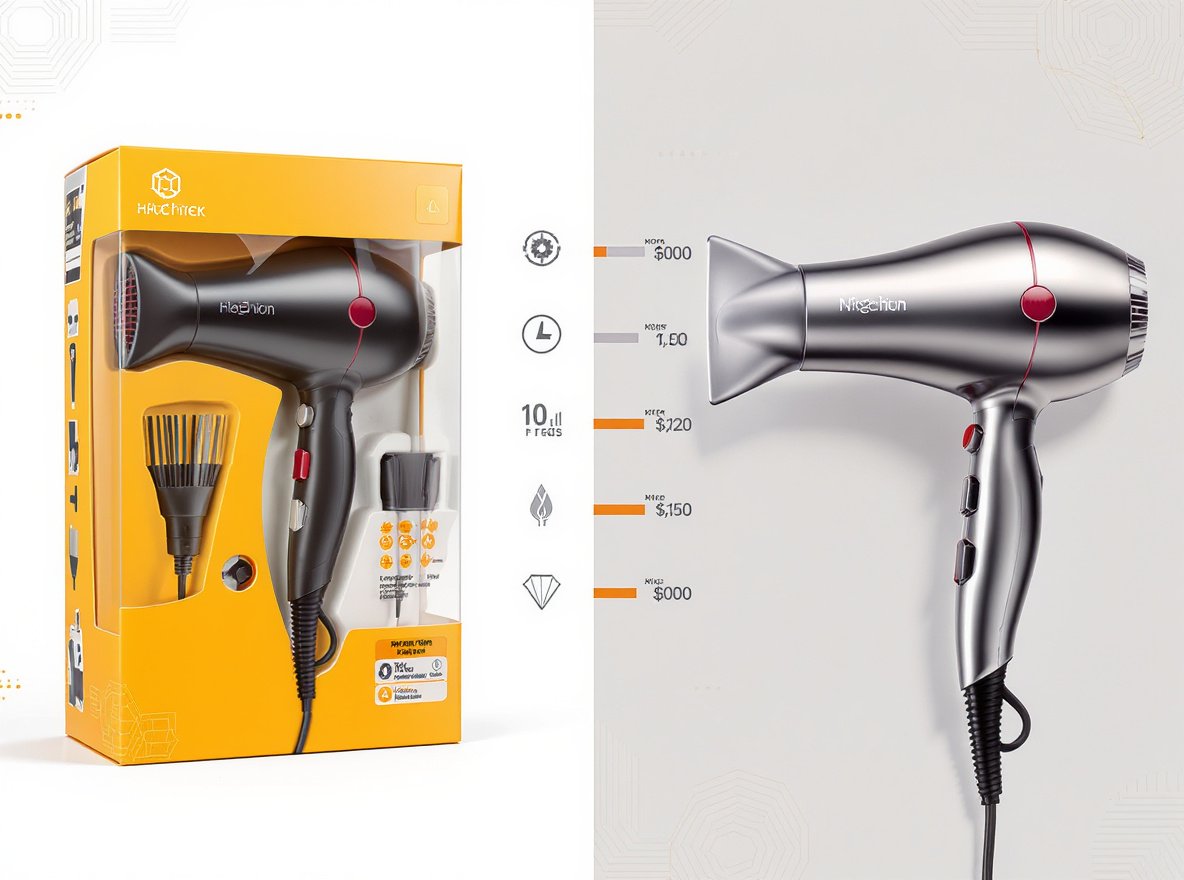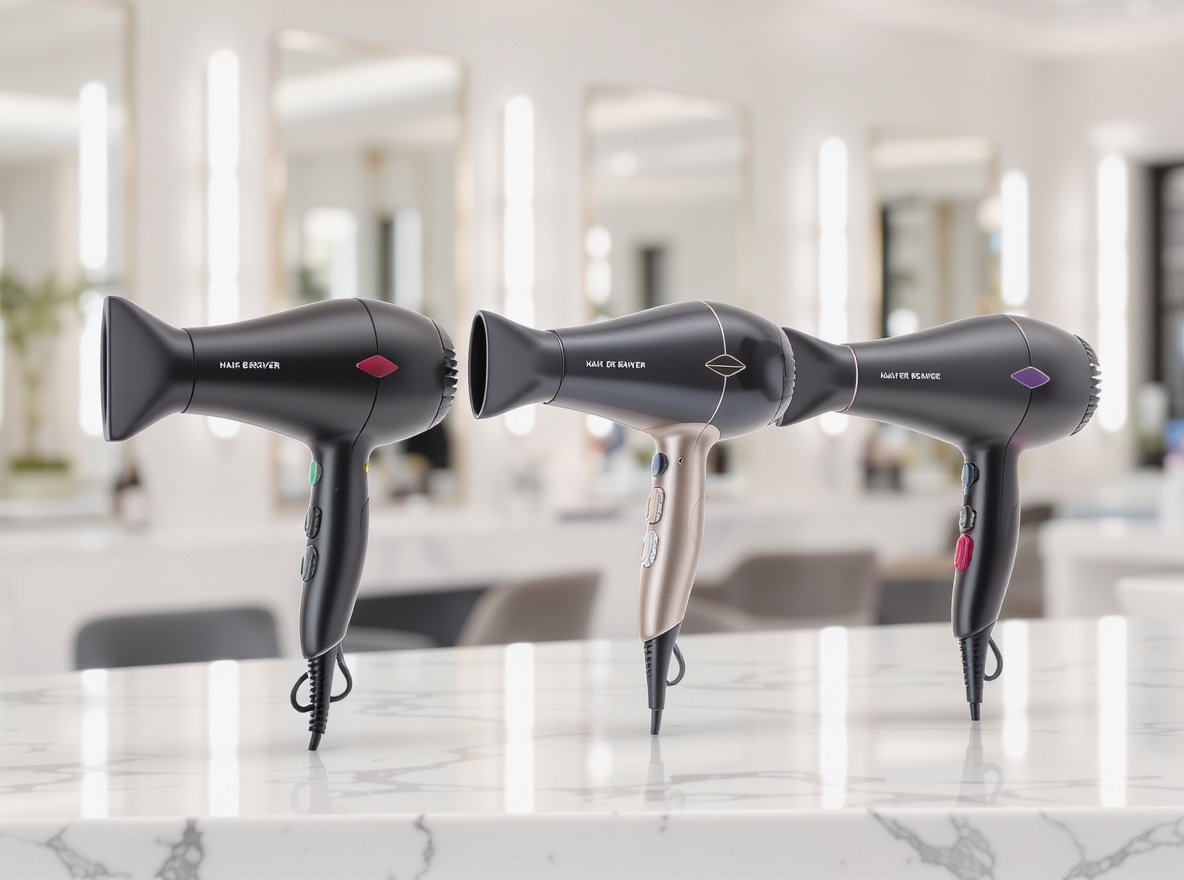Choosing the right motor type for professional salon dryers directly impacts your business success, affecting everything from styling efficiency to long-term operational costs. With 17.3% of hairdresser sick leaves caused by muscle and bone pain related to equipment use, motor selection becomes crucial for both performance and stylist wellbeing.
AC motors deliver powerful airflow with 1,875-2,200 watts and lifespans of 700-2,000 hours, making them ideal for high-volume salons. DC motors offer lighter weight and energy efficiency, while advanced BLDC motors combine the best of both technologies with exceptional durability and precision control.
Understanding these motor differences will help you stock the right products for your professional clientele and maximize your wholesale investment returns.
Table of Contents
ToggleHow Do AC Motors Work in Professional Hair Dryers?
AC motors represent the traditional powerhouse of professional salon equipment, designed specifically for demanding commercial environments where performance cannot be compromised.
AC motors operate directly from standard electrical outlets, utilizing alternating current that changes direction periodically to create rotating magnetic fields through electromagnetic induction. This direct power connection eliminates energy conversion losses, making them particularly effective for sustained professional use.
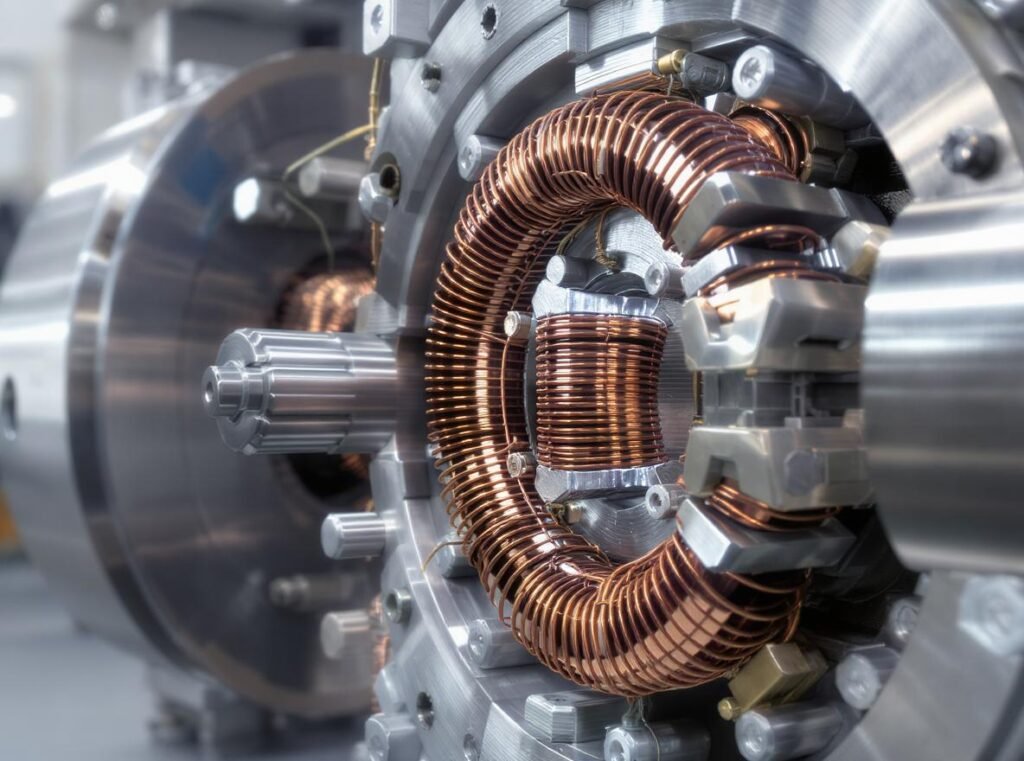
Professional AC motor hair dryers feature brushless designs that eliminate carbon brushes, resulting in more reliable operation and extended lifespan. The power delivery system enables these motors to handle high wattage operations efficiently, typically ranging from 1,875 to 2,200 watts.
The electromagnetic induction process drives a rotor to generate the mechanical energy needed for powerful airflow. This robust construction includes copper windings and permanent magnets that create strong electromagnetic fields, enabling consistent performance throughout long working days.
Key technical advantages for professional applications:
- Direct AC power connection prevents conversion energy losses
- Brushless design eliminates primary wear components
- Robust construction withstands continuous commercial operation
- High torque output maintains consistent airflow under load
| AC Motor Specification | Professional Benefit | Salon Impact |
|---|---|---|
| 1,875-2,200 watts | Powerful airflow generation | Faster client service |
| Direct power connection | No conversion losses | Energy efficiency |
| Brushless design | Reduced maintenance needs | Lower operational costs |
| 700-2,000 hour lifespan | Long-term reliability | Reduced replacement frequency |
What Makes DC Motors Different for Hair Dryer Applications?
DC motor technology has evolved significantly, with modern brushless DC (BLDC) motors revolutionizing hair dryer performance while traditional DC motors serve specific market segments.
Traditional DC motors require current conversion from AC household power through integrated rectifiers or adapters, operating on 12 to 36 volts with carbon brushes and commutators controlling current flow.
Brushless DC (BLDC) motors eliminate brushes entirely, using electronic controllers to manage current flow and achieve speeds up to 110,000 RPM. This represents a dramatic improvement over traditional motors, offering precise digital control and significantly reduced maintenance requirements.
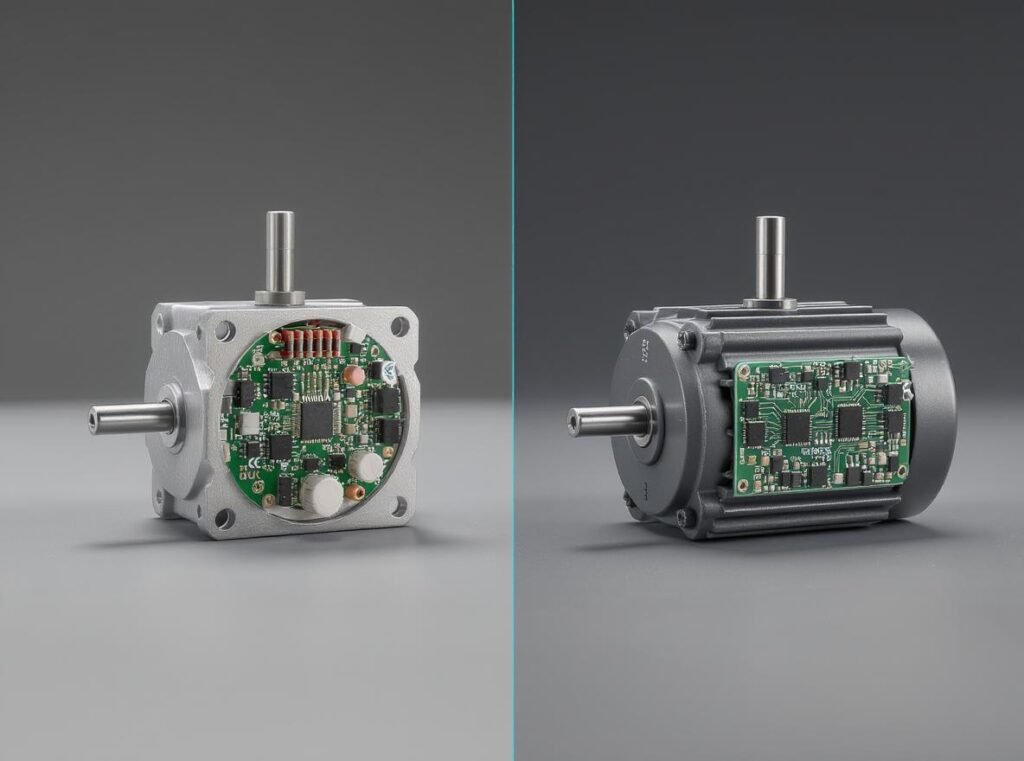
The evolution to BLDC technology has created three distinct DC motor categories:
Traditional brushed DC motors generate mechanical friction through brush contact, creating both noise and wear over time. These motors typically consume 800-1,800 watts while delivering lower airflow compared to AC alternatives.
BLDC motors achieve remarkable efficiency, consuming only 85-110 watts while delivering airflow comparable to much higher-wattage motors. This efficiency stems from optimized design and precise electronic control systems.
Advanced BLDC models incorporate digital temperature controls, variable speed settings, and intelligent heat management systems that protect both the motor and hair from damage.
Which Motor Type Offers Superior Durability for Professional Use?
Durability analysis reveals significant differences in operational lifespans that directly impact total cost of ownership for professional salon environments.
Professional salon equipment must withstand intensive daily use patterns that far exceed typical home applications, making motor longevity a critical investment consideration.
AC motors demonstrate superior longevity with operational lifespans ranging from 700 to 2,000 hours, making them ideal for busy salon environments. Their brushless design eliminates the primary wear component found in traditional motors, while robust construction withstands continuous professional use.

Durability comparison across motor types:
Traditional DC motors show limited durability with lifespans of 400-700 hours due to brush wear and mechanical friction. The carbon brushes require regular replacement, creating ongoing maintenance costs ranging from $50-100 annually and potential service downtime.
AC motors excel in commercial durability through their direct power design and elimination of complex conversion circuits. The larger motor housing provides superior heat dissipation, preventing overheating during extended use periods common in professional settings.
BLDC motors offer exceptional durability, often exceeding 2,000 hours of operation with some manufacturers providing up to 10-year warranties. Their brushless design eliminates mechanical wear points, while advanced electronic controls prevent damage from overheating or electrical surges.
| Motor Type | Average Lifespan | Maintenance Requirements | Professional Suitability |
|---|---|---|---|
| Traditional DC | 400-700 hours | High (brush replacement) | Limited commercial use |
| AC Motor | 700-2,000 hours | Low (minimal service) | Excellent for high-volume |
| BLDC Motor | 2,000+ hours | Minimal (electronic only) | Premium professional use |
How Do Power Output and Performance Compare Across Motor Types?
Performance analysis reveals dramatic differences in power efficiency and airflow generation that directly impact styling effectiveness and client satisfaction.
Power consumption versus actual performance creates distinct value propositions for different professional applications, with efficiency becoming increasingly important for operational costs.
AC motors deliver powerful airflow through high wattage operation, typically consuming 1,875-2,200 watts while producing strong, consistent airflow ideal for thick or challenging hair textures. Their direct AC power connection ensures efficient energy transfer without conversion losses.
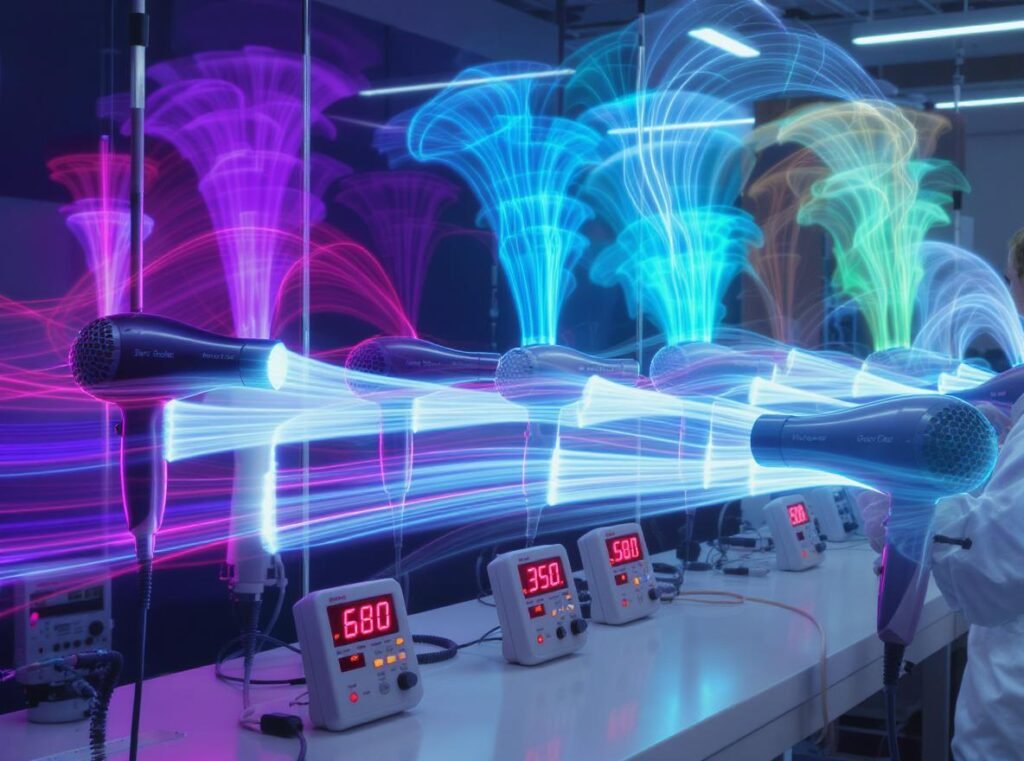
Performance characteristics by motor type:
AC motors excel in raw power delivery, generating high-volume airflow at greater pressure for penetrating thick hair sections effectively. Heat distribution benefits from consistent power delivery, maintaining even temperature distribution across airflow patterns.
Traditional DC motors operate at 800-1,800 watts but deliver lower airflow compared to AC motors due to design limitations. The power conversion process introduces energy losses, reducing overall efficiency and extending styling time requirements.
BLDC motors achieve remarkable efficiency breakthrough, consuming only 85-110 watts while delivering airflow comparable to much higher-wattage motors. This efficiency stems from optimized aerodynamic design and precise electronic control enabling 100,000+ RPM speeds.
Advanced BLDC models provide precise digital controls for:
- Variable speed adjustment (multiple settings)
- Exact temperature regulation
- Intelligent heat protection systems
- Customizable airflow patterns
Professional styling applications require different performance characteristics. Sectioning work demands consistent airflow for uniform results, while volume creation needs powerful air pressure for root lifting techniques.
What Are the Weight and Ergonomic Implications for Stylists?
Ergonomic considerations significantly impact stylist health and productivity, with motor weight and balance directly affecting long-term occupational wellbeing and work efficiency.
Research indicates that 17.3% of hairdresser sick leaves are caused by muscle and bone pain related to equipment use, making ergonomic design crucial for professional applications.
AC motors are typically the heaviest option, weighing 2+ pounds due to larger motor housings and robust construction, but their powerful performance can reduce styling time, potentially offsetting the weight disadvantage.

Weight and ergonomic analysis:
AC motors require careful ergonomic consideration despite superior performance. Modern professional-grade models feature balanced weight distribution centering motor mass closer to handles, reducing wrist strain. Anti-slip surfaces and contoured handles improve comfort during extended use sessions.
Traditional DC motors offer moderate weight reduction, typically weighing 1-1.5 pounds. While lighter than AC motors, their lower performance may require longer styling sessions, potentially negating ergonomic benefits through extended exposure.
BLDC motors provide exceptional ergonomic advantages, weighing less than 1 pound while maintaining professional-grade performance. Some advanced models weigh as little as 249 grams (0.55 pounds) while delivering equivalent power to 2,200-watt traditional motors.
Critical ergonomic factors for professional use:
- Arm positioning during blow-drying causes more strain than absolute weight
- Elevated arm positions for more than 4 minutes increase neck and shoulder pain
- Lighter motors enable better positioning and reduce cumulative fatigue
- Balance distribution affects wrist strain more than total weight
| Weight Category | AC Motors | Traditional DC | BLDC Motors | Ergonomic Impact |
|---|---|---|---|---|
| Average Weight | 2+ pounds | 1-1.5 pounds | <1 pound | Fatigue reduction |
| Balance Design | Motor-heavy | Moderate | Optimized | Wrist strain prevention |
| Extended Use Comfort | Requires breaks | Moderate comfort | Excellent comfort | Professional productivity |
How Do Operating Costs Compare Between Motor Technologies?
Total cost of ownership analysis reveals complex relationships between initial investment, energy consumption, maintenance requirements, and replacement frequency that significantly impact long-term profitability.
Professional salon operations must balance performance requirements with operational efficiency to maintain competitive service pricing while delivering quality results.
Hair dryers typically cost $0.25 per minute to operate at full power, but motor efficiency and durability create significant long-term cost variations between technologies.

Operating cost analysis by motor type:
AC motors demonstrate cost-effectiveness through faster drying times and longer operational life, despite higher initial power consumption. Their 1,875-2,200 watt consumption coupled with superior airflow often results in shorter styling sessions, reducing total energy costs per client.
Traditional DC motors offer lower initial purchase costs but generate higher long-term expenses through frequent brush replacement ($50-100 annually) and shorter lifespans requiring more frequent equipment replacement.
BLDC motors require the highest initial investment but deliver lowest operating costs through minimal maintenance requirements and exceptional energy efficiency. Their 85-110 watt consumption compared to 1,500+ watts for traditional motors creates substantial energy savings over time.
Professional volume usage amplifies cost differences significantly:
Daily energy consumption calculations for salons operating 6-8 hours daily show annual energy cost differences of $200-400 between motor types. BLDC motors provide the lowest operational expenses despite higher purchase prices, while AC motors offer balanced cost-performance for high-volume applications.
Maintenance cost considerations include service calls, component replacement, and equipment downtime. AC motors typically require minimal service beyond routine cleaning, while traditional DC motors need regular brush replacement and related repairs.
Which Motor Type Suits Different Professional Applications Best?
Application-specific analysis reveals distinct performance requirements that favor different motor technologies, enabling optimal equipment selection for various professional scenarios.
Professional hair styling encompasses diverse specialized applications, each with unique demands for power, durability, precision, and portability that determine optimal motor choice.
High-volume salons benefit most from AC motors due to their robust construction, powerful airflow, and proven durability under intensive use. These environments require consistent performance throughout 8-12 hour operating days with multiple stylists serving numerous clients.
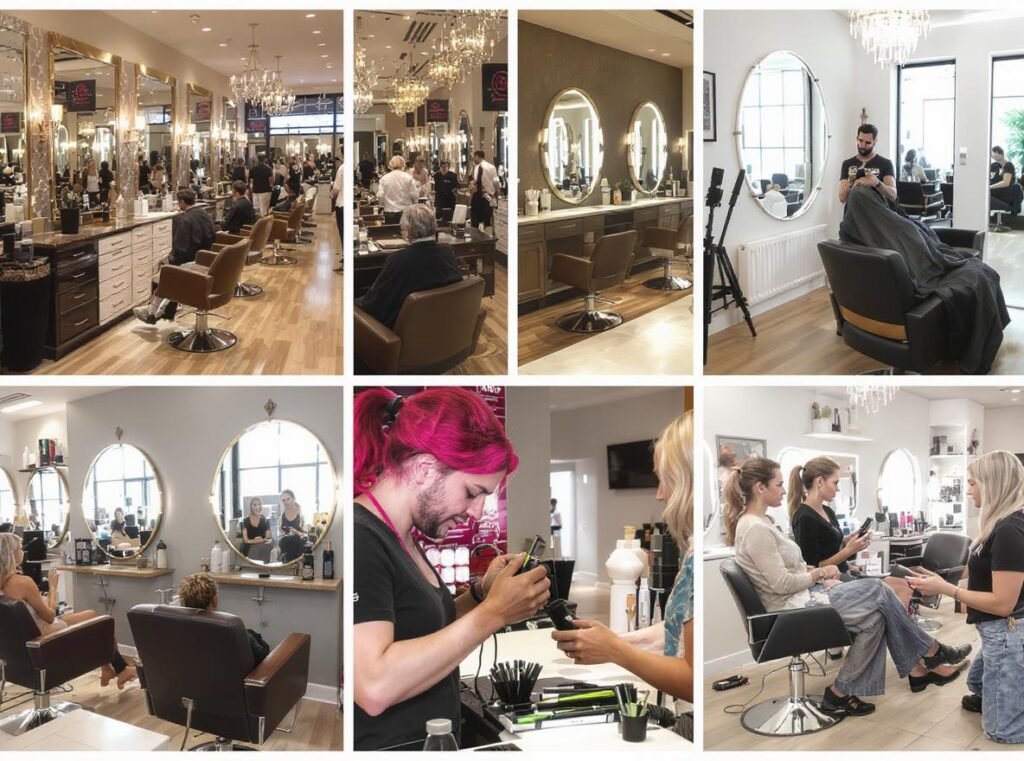
Application-specific motor recommendations:
High-volume commercial salons require maximum reliability and consistent performance. AC motors excel in these demanding environments through their powerful 1,875-2,200 watt output and 700-2,000 hour operational life, supporting continuous daily operation without performance degradation.
Premium salons and spas increasingly adopt BLDC motors for their quiet operation, precision control, and advanced features. These settings prioritize client comfort and premium service experience, where reduced noise levels and precise temperature control justify higher equipment investments.
Mobile stylists and event services face unique portability challenges. BLDC motors provide ideal solutions through their lightweight design (under 1 pound) and compatibility with cordless operation, while maintaining professional-grade performance for on-location services.
Training facilities and beauty schools must balance cost considerations with educational value. AC motors provide students with professional-grade experience while offering durability to withstand intensive educational use and inexperienced handling.
Specialty services including texture specialists and curly hair experts benefit from BLDC motor precision, with digital controls enabling exact temperature and airflow adjustment for different hair types and specialized styling techniques.
| Application Type | Recommended Motor | Primary Advantage | Business Impact |
|---|---|---|---|
| High-Volume Salons | AC | Durability & Power | Consistent daily performance |
| Premium Services | BLDC | Precision & Quiet Operation | Enhanced client experience |
| Mobile/Event Styling | BLDC | Lightweight & Portability | Service flexibility |
| Training Facilities | AC | Cost-Effective Durability | Professional education quality |
| Specialty Techniques | BLDC | Precision Control | Advanced styling capabilities |
What Should Wholesale Buyers Prioritize When Selecting Motor Types?
Strategic purchasing decisions require comprehensive analysis of customer segments, market positioning, and long-term value propositions to maximize sales success and customer satisfaction.
Wholesale buyers must balance initial investment costs with customer requirements, market demand patterns, and competitive positioning to build profitable product portfolios that serve diverse professional needs.
Volume purchasing advantages become significant when selecting motor types, with AC motors offering established supply chains and competitive bulk pricing, while BLDC motors provide premium positioning and higher profit margins.

Market segmentation analysis reveals distinct customer priorities:
Professional salon customers prioritize performance and durability over initial cost, making AC motors ideal for high-volume commercial applications. These customers understand equipment investment value and focus on operational efficiency and long-term reliability.
Premium market segments increasingly demand BLDC technology for its advanced features, energy efficiency, and ergonomic advantages. These customers willingly pay higher prices for superior performance and innovative features.
Budget-conscious segments respond well to traditional DC motors despite limitations, creating entry-level market opportunities for price-sensitive customers requiring basic functionality.
Strategic purchasing considerations:
Supply chain reliability requires evaluation of manufacturer stability and component availability. AC motor suppliers provide established relationships and predictable pricing structures, while BLDC technology involves more complex supply chains but offers higher profit margins.
Technical support and warranty coverage vary significantly between technologies. AC motors benefit from widespread service networks and readily available parts, while BLDC motors require specialized technical support but often include extended warranties up to 10 years.
Regulatory compliance becomes increasingly important, with energy efficiency standards favoring BLDC motors in many international markets. Professional certifications and safety standards must be verified for all motor types, particularly for global distribution.
Training and support requirements differ substantially. AC motors require minimal specialized knowledge for sales and service, while BLDC motors may need technical training for optimal customer utilization and support.
For professional clients seeking high-performance solutions that combine AC motor reliability with modern efficiency, we recommend exploring our P1C high-speed hair dryer, which delivers professional-grade performance optimized for demanding salon environments.
Summary
AC motors excel in high-volume professional environments through superior power output (1,875-2,200 watts) and extended lifespans (700-2,000 hours), making them ideal for busy salons requiring consistent performance. BLDC motors represent premium technology with exceptional efficiency (85-110 watts), lightweight design (under 1 pound), and advanced digital controls, perfect for upscale salons and mobile services. Traditional DC motors serve budget-conscious applications but lack the durability and performance required for intensive professional use. Wholesale buyers should align motor selection with target customer segments and market positioning strategies.

Ready to explore professional-grade hair dryer solutions that maximize your customers’ salon productivity? Browse our complete motor technology lineup and contact our wholesale team for competitive pricing, technical specifications, and market-specific recommendations that drive your business success.


